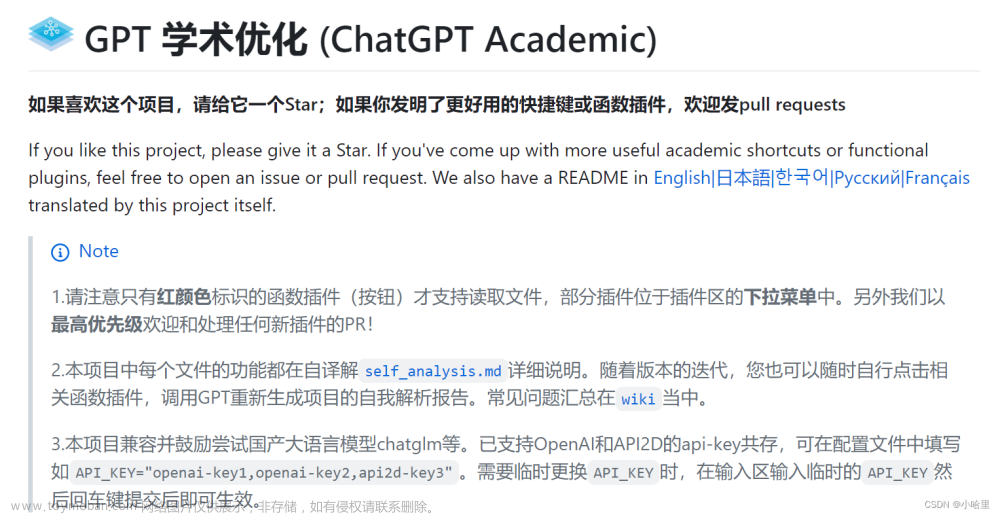introduction
如何自定义量化优化过程,以及如何手动调用优化过程文章来源地址https://www.toymoban.com/news/detail-716038.html
code
from typing import Callable, Iterable
import torch
import torchvision
from ppq import QuantizationSettingFactory, TargetPlatform
from ppq.api import (ENABLE_CUDA_KERNEL, QuantizationSettingFactory,
quantize_torch_model)
from ppq.core import QuantizationStates
from ppq.executor.torch import TorchExecutor
from ppq.IR.quantize import QuantableOperation
# ------------------------------------------------------------
# 在这个例子中,我们将向你介绍如何自定义量化优化过程,以及如何手动调用优化过程
# ------------------------------------------------------------
BATCHSIZE = 32
INPUT_SHAPE = [BATCHSIZE, 3, 224, 224]
DEVICE = 'cuda'
PLATFORM = TargetPlatform.TRT_INT8
# ------------------------------------------------------------
# 和往常一样,我们要创建 calibration 数据,以及加载模型
# ------------------------------------------------------------
def load_calibration_dataset() -> Iterable:
return [torch.rand(size=INPUT_SHAPE) for _ in range(32)]
CALIBRATION = load_calibration_dataset()
def collate_fn(batch: torch.Tensor) -> torch.Tensor:
return batch.to(DEVICE)
model = torchvision.models.mobilenet.mobilenet_v2(pretrained=True)
model = model.to(DEVICE)
# ------------------------------------------------------------
# 下面,我们将向你展示如何不借助 QSetting 来自定义优化过程
# QSetting 中包含了 PPQ 官方量化过程的配置参数,你可以借助它来调用所有系统内置优化过程
# 但如果你设计了新的优化过程,你将必须在合适的时机手动启动他们
# ------------------------------------------------------------
QSetting = QuantizationSettingFactory.default_setting()
# 不要进行 Parameter Baking 操作,一旦 Parameter 完成 Baking,后续任何对于参数的修改都是不被允许的
# 你可以设置 baking_parameter = True 并再次执行这个脚本,PPQ 系统会拒绝后续修改 scale 的请求
QSetting.quantize_parameter_setting.baking_parameter = False
# ------------------------------------------------------------
# 定义我们自己的优化过程,继承 QuantizationOptimizationPass 基类,实现 optimize 接口
# 在 optimize 接口函数中,你可以修改图的属性从而实现特定目的
# 在这个例子中,我们将图中所有卷积的输入 scale 变换为原来的两倍
# 同时,我们解除最后一个 Gemm 的输入量化
# ------------------------------------------------------------
from ppq import BaseGraph, QuantizationOptimizationPass, TorchExecutor
class MyOptim(QuantizationOptimizationPass):
def optimize(self, graph: BaseGraph, dataloader: Iterable,
collate_fn: Callable, executor: TorchExecutor, **kwargs) -> None:
# graph.operations 是一个包含了图中所有 op 的字典
for name, op in graph.operations.items():
# 从图中找出所有已经量化的卷积算子
# 对于你的网络而言,并非所有算子最终都会被量化,他们会受到 调度策略 和 Quantizer策略 的双重限制
# 因此我们要使用 isinstance(op, QuantableOperation) 来判断它是否是一个量化的算子
if op.type == 'Conv' and isinstance(op, QuantableOperation):
# 对于卷积算子,它可能有 2-3 个输入,其中第二个输入为权重,第三个输入为 bias
# 我们修改权重量化信息的 scale
op.input_quant_config[1].scale *= 2
print(f'Input scale of Op {name} has been enlarged.')
# 我们接下来解除 Gemm 的量化,在这里 mobilenet_v2 网络只有一个 Gemm 层
# 所以我们将所有遇到的 Gemm 的层全部解除量化
if op.type == 'Gemm' and isinstance(op, QuantableOperation):
# config_with_variable 接口将返回量化算子的所有量化信息————包括输入与输出
for cfg, _ in op.config_with_variable:
# 在 PPQ 中有许多方法可以切换算子的量化状态
# 将量化状态直接设置为 FP32,即解除了算子的量化
cfg.state = QuantizationStates.FP32
# 也可以直接调用算子的 dequantize 方法
# op.dequantize()
# ------------------------------------------------------------
# 如果你使用 ENABLE_CUDA_KERNEL 方法
# PPQ 将会尝试编译自定义的高性能量化算子,这一过程需要编译环境的支持
# 如果你在编译过程中发生错误,你可以删除此处对于 ENABLE_CUDA_KERNEL 方法的调用
# 这将显著降低 PPQ 的运算速度;但即使你无法编译这些算子,你仍然可以使用 pytorch 的 gpu 算子完成量化
# ------------------------------------------------------------
with ENABLE_CUDA_KERNEL():
quantized = quantize_torch_model(
model=model, calib_dataloader=CALIBRATION,
calib_steps=32, input_shape=INPUT_SHAPE,
setting=QSetting, collate_fn=collate_fn, platform=PLATFORM,
onnx_export_file='./model.onnx', device=DEVICE, verbose=0)
# ------------------------------------------------------------
# 在完成量化流程之后,我们调用我们自定义的量化优化过程从而修改量化参数
# ------------------------------------------------------------
optim = MyOptim(name='My Optimization Procedure')
optim.optimize(graph=quantized, dataloader=CALIBRATION,
collate_fn=INPUT_SHAPE, executor=TorchExecutor(quantized, device=DEVICE))
result
____ ____ __ ____ __ __
/ __ \/ __ \/ / / __ \__ ______ _____ / /_____ ____ / /
/ /_/ / /_/ / / / / / / / / / __ `/ __ \/ __/ __ \/ __ \/ /
/ ____/ ____/ /__/ /_/ / /_/ / /_/ / / / / /_/ /_/ / /_/ / /
/_/ /_/ /_____\___\_\__,_/\__,_/_/ /_/\__/\____/\____/_/
[31m[Warning] Compling Kernels... Please wait (It will take a few minutes).[0m
[07:08:25] PPQ Quantization Config Refine Pass Running ... Finished.
[07:08:25] PPQ Quantization Fusion Pass Running ... Finished.
[07:08:25] PPQ Quantize Simplify Pass Running ... Finished.
[07:08:25] PPQ Parameter Quantization Pass Running ... Finished.
[07:08:25] PPQ Runtime Calibration Pass Running ...
Calibration Progress(Phase 1): 0%| | 0/32 [00:00<?, ?it/s]
Calibration Progress(Phase 1): 3%|▎ | 1/32 [00:00<00:11, 2.74it/s]
Calibration Progress(Phase 1): 6%|▋ | 2/32 [00:00<00:10, 2.86it/s]
Calibration Progress(Phase 1): 9%|▉ | 3/32 [00:01<00:09, 2.97it/s]
Calibration Progress(Phase 1): 12%|█▎ | 4/32 [00:01<00:09, 3.09it/s]
Calibration Progress(Phase 1): 16%|█▌ | 5/32 [00:01<00:08, 3.08it/s]
Calibration Progress(Phase 1): 19%|█▉ | 6/32 [00:01<00:08, 3.13it/s]
Calibration Progress(Phase 1): 22%|██▏ | 7/32 [00:02<00:08, 3.04it/s]
Calibration Progress(Phase 1): 25%|██▌ | 8/32 [00:02<00:07, 3.07it/s]
Calibration Progress(Phase 1): 28%|██▊ | 9/32 [00:02<00:07, 3.01it/s]
Calibration Progress(Phase 1): 31%|███▏ | 10/32 [00:03<00:06, 3.38it/s]
Calibration Progress(Phase 1): 34%|███▍ | 11/32 [00:03<00:06, 3.08it/s]
Calibration Progress(Phase 1): 38%|███▊ | 12/32 [00:03<00:06, 3.13it/s]
Calibration Progress(Phase 1): 41%|████ | 13/32 [00:04<00:06, 3.04it/s]
Calibration Progress(Phase 1): 44%|████▍ | 14/32 [00:04<00:06, 2.88it/s]
Calibration Progress(Phase 1): 47%|████▋ | 15/32 [00:04<00:05, 3.03it/s]
Calibration Progress(Phase 1): 50%|█████ | 16/32 [00:05<00:05, 2.93it/s]
Calibration Progress(Phase 1): 53%|█████▎ | 17/32 [00:05<00:04, 3.22it/s]
Calibration Progress(Phase 1): 56%|█████▋ | 18/32 [00:05<00:04, 3.15it/s]
Calibration Progress(Phase 1): 59%|█████▉ | 19/32 [00:06<00:03, 3.35it/s]
Calibration Progress(Phase 1): 62%|██████▎ | 20/32 [00:06<00:03, 3.07it/s]
Calibration Progress(Phase 1): 66%|██████▌ | 21/32 [00:06<00:03, 3.21it/s]
Calibration Progress(Phase 1): 69%|██████▉ | 22/32 [00:07<00:03, 3.19it/s]
Calibration Progress(Phase 1): 72%|███████▏ | 23/32 [00:07<00:02, 3.16it/s]
Calibration Progress(Phase 1): 75%|███████▌ | 24/32 [00:07<00:02, 3.10it/s]
Calibration Progress(Phase 1): 78%|███████▊ | 25/32 [00:08<00:02, 3.12it/s]
Calibration Progress(Phase 1): 81%|████████▏ | 26/32 [00:08<00:01, 3.10it/s]
Calibration Progress(Phase 1): 84%|████████▍ | 27/32 [00:08<00:01, 3.00it/s]
Calibration Progress(Phase 1): 88%|████████▊ | 28/32 [00:09<00:01, 3.12it/s]
Calibration Progress(Phase 1): 91%|█████████ | 29/32 [00:09<00:01, 2.98it/s]
Calibration Progress(Phase 1): 94%|█████████▍| 30/32 [00:09<00:00, 3.07it/s]
Calibration Progress(Phase 1): 97%|█████████▋| 31/32 [00:10<00:00, 2.89it/s]
Calibration Progress(Phase 1): 100%|██████████| 32/32 [00:10<00:00, 3.02it/s]
Calibration Progress(Phase 1): 100%|██████████| 32/32 [00:10<00:00, 3.07it/s]
Finished.
[07:08:36] PPQ Quantization Alignment Pass Running ... Finished.
[07:08:36] PPQ Passive Parameter Quantization Running ... Finished.
--------- Network Snapshot ---------
Num of Op: [100]
Num of Quantized Op: [54]
Num of Variable: [277]
Num of Quantized Var: [207]
------- Quantization Snapshot ------
Num of Quant Config: [214]
ACTIVATED: [108]
FP32: [106]
Network Quantization Finished.
Input scale of Op Conv_0 has been enlarged.
Input scale of Op Conv_4 has been enlarged.
Input scale of Op Conv_8 has been enlarged.
Input scale of Op Conv_9 has been enlarged.
Input scale of Op Conv_13 has been enlarged.
Input scale of Op Conv_17 has been enlarged.
Input scale of Op Conv_18 has been enlarged.
Input scale of Op Conv_22 has been enlarged.
Input scale of Op Conv_26 has been enlarged.
Input scale of Op Conv_28 has been enlarged.
Input scale of Op Conv_32 has been enlarged.
Input scale of Op Conv_36 has been enlarged.
Input scale of Op Conv_37 has been enlarged.
Input scale of Op Conv_41 has been enlarged.
Input scale of Op Conv_45 has been enlarged.
Input scale of Op Conv_47 has been enlarged.
Input scale of Op Conv_51 has been enlarged.
Input scale of Op Conv_55 has been enlarged.
Input scale of Op Conv_57 has been enlarged.
Input scale of Op Conv_61 has been enlarged.
Input scale of Op Conv_65 has been enlarged.
Input scale of Op Conv_66 has been enlarged.
Input scale of Op Conv_70 has been enlarged.
Input scale of Op Conv_74 has been enlarged.
Input scale of Op Conv_76 has been enlarged.
Input scale of Op Conv_80 has been enlarged.
Input scale of Op Conv_84 has been enlarged.
Input scale of Op Conv_86 has been enlarged.
Input scale of Op Conv_90 has been enlarged.
Input scale of Op Conv_94 has been enlarged.
Input scale of Op Conv_96 has been enlarged.
Input scale of Op Conv_100 has been enlarged.
Input scale of Op Conv_104 has been enlarged.
Input scale of Op Conv_105 has been enlarged.
Input scale of Op Conv_109 has been enlarged.
Input scale of Op Conv_113 has been enlarged.
Input scale of Op Conv_115 has been enlarged.
Input scale of Op Conv_119 has been enlarged.
Input scale of Op Conv_123 has been enlarged.
Input scale of Op Conv_125 has been enlarged.
Input scale of Op Conv_129 has been enlarged.
Input scale of Op Conv_133 has been enlarged.
Input scale of Op Conv_134 has been enlarged.
Input scale of Op Conv_138 has been enlarged.
Input scale of Op Conv_142 has been enlarged.
Input scale of Op Conv_144 has been enlarged.
Input scale of Op Conv_148 has been enlarged.
Input scale of Op Conv_152 has been enlarged.
Input scale of Op Conv_154 has been enlarged.
Input scale of Op Conv_158 has been enlarged.
Input scale of Op Conv_162 has been enlarged.
Input scale of Op Conv_163 has been enlarged.
文章来源:https://www.toymoban.com/news/detail-716038.html
到了这里,关于2.10、自定义量化优化过程的文章就介绍完了。如果您还想了解更多内容,请在右上角搜索TOY模板网以前的文章或继续浏览下面的相关文章,希望大家以后多多支持TOY模板网!














